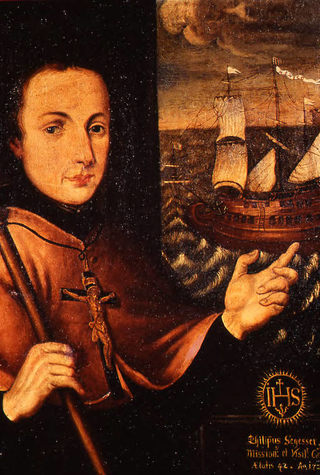Related Research Articles

The Acaxee or Acaxees were a tribe or group of tribes in the Sierra Madre Occidental in eastern Sinaloa and NW Durango. They spoke a Taracahitic language in the Southern Uto-Aztecan language family. Their culture was based on horticulture and the exploitation of wild animal and plant life. They are now extinct as an identifiable ethnic group.
Santiago is a small town in Los Cabos Municipality in Baja California Sur, Mexico, located on Mexico's Highway 1, about an hour's drive north of San José del Cabo. Like Todos Santos it is almost directly on top of the Tropic of Cancer.
The First Magdalena massacre was an attack by Seri Native Americans against the Spanish mission village of Magdalena de Kino, in the present day northern Mexico. The attack occurred on November 3, 1757 and was the first of two massacres at the town. The second attack came almost exactly nineteen years later in November, 1776. Not much is known except for the deaths of thirty-one men, women and children, as well as Jesuit missionaries.

Philipp Segesser was a German-speaking Swiss Jesuit missionary who spent much of his career in Sonora, Mexico.

Mission San Cosme y Damián de Tucsón, originally known as Mission San Agustín del Tucson, was a Spanish mission located in present-day Tucson, Pima County, Arizona. It was established in 1692 by Jesuit missionary Eusebio Francisco Kino as a visita, or "visiting chapel", of the nearby Mission San Xavier del Bac. Today, almost nothing remains of the original complex.

The Province of Las Californias was a Spanish Empire province in the northwestern region of New Spain. Its territory consisted of the entire U.S. states of California, Nevada, and Utah, parts of Arizona, Wyoming, and Colorado, and the Mexican states of Baja California and Baja California Sur.
Ignacio Xavier Keller was a Jesuit missionary to Mexico at Mission Santa María Suamca. His treatment of Pima leader Luis Oacpicagigua was an inciting factor in the Pima Revolt of 1751.
Luis Xavier Velarde (1677–1737) was a Jesuit missionary to Mexico.
Juan Bautista Grazhoffer (1690–1733) was a Jesuit missionary to the Sonoran Desert. He served briefly at Mission Los Santos Ángeles de Guevavi before his death, possibly by poison.
Joseph Garrucho (1712–1785) was a Jesuit missionary to Mexico, who served at Mission Los Santos Ángeles de Guevavi and Mission San Miguel Arcángel de Oposura. He was implicated in the events leading up to the Pima Revolt of 1751.
Francisco Xavier Pauer was a Jesuit missionary to Mexico. He replaced Joseph Garrucho at Mission Los Santos Ángeles de Guevavi after the Pima Revolt of 1751, and worked in the area until the expulsion of the Jesuits in 1767.
Custodio Ximeno was a Jesuit missionary to New Spain. He served at Mission Los Santos Ángeles de Guevavi from 1763 until the 1767 expulsion of the Jesuits from Mexico.
Alexandro Rapicani was a Jesuit missionary to New Spain.
Luís María Gallardi was a Jesuit missionary to New Spain.
Francisco Antonio Barbastro (1735–1800) was a Franciscan missionary in New Spain.
Jacobo Sedelmayr (1702–1779) was a Jesuit missionary in New Spain, known for his explorations of the Pimería Alta.
Daniel Januske was a Jesuit missionary in New Spain.
Alejandro Romano (1664–1724) was a Jesuit missionary in New Spain.
Andrés Xavier García was a Jesuit missionary in New Spain.
References
- ↑ Segesser, Philipp (April 2014). Thompson, Raymond H. (ed.). A Jesuit Missionary in Eighteenth-Century Sonora: The Family Correspondence of Philipp Segesser. University of New Mexico Press. p. 235. ISBN 978-0-8263-5424-2.
- ↑ Polzer, Charles W. (1976). Rules and precepts of the Jesuit missions of northwestern New Spain. Tucson : University of Arizona Press. pp. 23–24. ISBN 978-0-8165-0551-7 . Retrieved 5 May 2024.
- ↑ Yetman, David (15 November 2010). The Ópatas: In Search of a Sonoran People. University of Arizona Press. p. 296. ISBN 978-0-8165-0109-0.